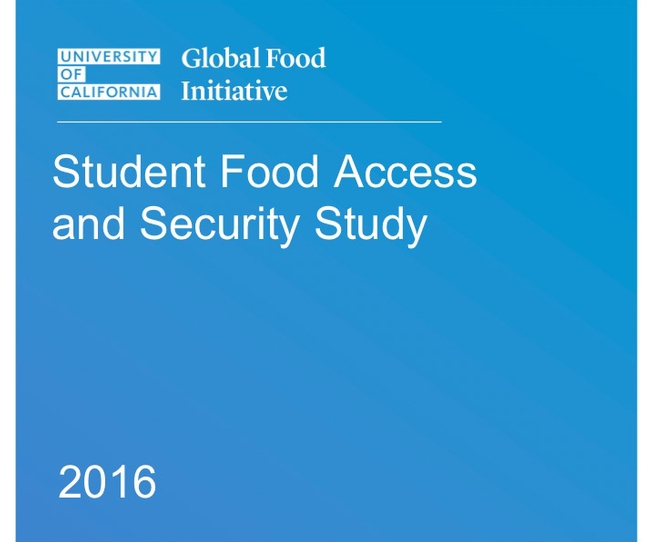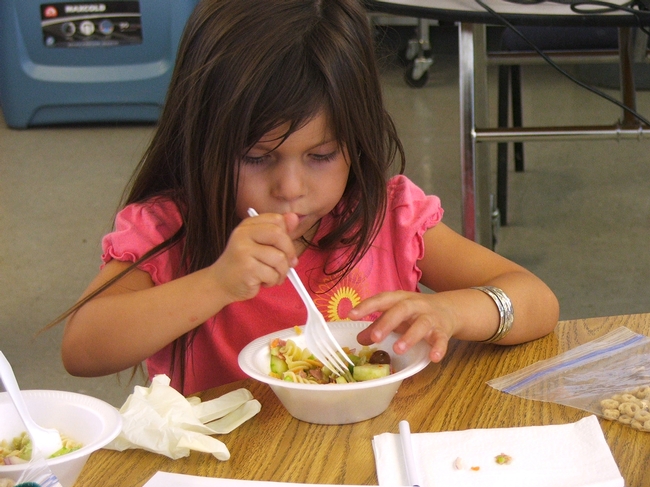Posts Tagged: Nutrition Policy Institute
Nutrition Policy Institute study highlights benefits of school lunch
Lunches served in the National School Lunch Program have higher nutritional quality than lunches brought from home, according to the largest comparison study conducted to date.
Published in the November 2016 issue of the Journal of the Academy of Nutrition and Dietetics, the study, conducted by researchers at UC's Nutrition Policy Institute, involved nearly 4,000 elementary school students in Southern California.
“This rigorous study confirms what we have long known: The school lunch program, which has served the country's students since 1946, makes an invaluable contribution to their nutritional well-being, their health and their academic performance," said Lorrene Ritchie, Ph.D., director of the Nutrition Policy Institute and a senior author of this study. "And thanks to the recent, improved nutrition standards, it will only provide stronger, more essential support for our children's success.”
School lunch consumption was associated with higher overall diet quality. School lunch eaters also consumed diets that were higher in dairy-rich foods, lower in empty calories from solid fats and added sugars, and lower in refined grains than students who ate lunches from home.
Established in 1946, the National School Lunch Program is a federal nutrition assistance program that provides nutritionally balanced, low-cost or free lunches in over 100,000 K-12 schools throughout the United States. School lunches are required to meet certain nutrition standards based on the latest Dietary Guidelines for Americans. New requirements increase the availability of fruits, vegetables and whole grains and reduce sodium and fat in school lunches. Guidelines on calorie limits are set to ensure age-appropriate sized meals for grades K-5, 6-8 and 9-12.
During the 2014-15 school year, the program served lunches to about 30.5 million children each school day. More than 21.5 million of these students qualified for free or reduced-price service. Given the program's broad reach and its targeting of low-income children, the nutritional improvements shown in this study are of considerable benefit to needy students for whom school lunch may represent roughly one-third of their daily calories.
Since the study was conducted, new and more rigorous nutritional standards have been implemented, thus increasing the likelihood that school lunches are contributing to healthy overall diets – and reversing the extremely worrisome obesity epidemic. Currently as many as one-third of U.S. youth are obese or overweight.
UC commits $3.3 million to tackle food access issues
Guided by the findings of an in-depth University of California survey, UC President Janet Napolitano has approved $3.3 million in new funding over the next two years to help students regularly access nutritious food on campus and off, UC announced today (July 11).
The funding, which includes $151,000 for each of UC's 10 campuses, is in addition to the $75,000 per campus that Napolitano allocated in 2015 to address the immediate challenges of ensuring that students have ready access to nutritious food, and reflects the UC Global Food Initiative goal of promoting a nutritious, sustainable food supply.
“Food security is a critical issue not only on college campuses, but throughout our country and the world,” Napolitano said. “We undertook this survey, and are acting on its findings, because the University is serious about addressing real, long-term solutions to improve the well-being of our students.”
To better gauge the food security of its students, UC administered an online survey in spring 2015 to a randomly selected sample of students from all UC campuses. Of the 66,000 students asked to participate, nearly 9,000 completed the survey – a 14 percent response rate. Undergraduate and graduate students were invited to participate in one of two ways: through the National College Health Assessment II survey administered by the American College Health Association, or through an independent campus survey administered by the UC Office of the President‘s Institutional Research and Academic Planning Division. In both formats, the survey utilized a six-item U.S. Department of Agriculture food security module.
The survey responses were evaluated by the UC Nutrition Policy Institute, part of UC Agriculture and Natural Resources.
According to the survey, 19 percent of UC students indicated they had “very low” food security, which the USDA defines as experiencing reduced food intake at times due to limited resources. An additional 23 percent were characterized as having “low” food security, defined by the USDA as reduced quality, variety or desirability of diet, with little or no indication of reduced food intake.
Based on the results of this Food Access and Security study and in conjunction with student representatives systemwide, UC developed an action plan tailored to the needs of individual campuses while maximizing coordination among them. The plan includes:
- Expanding food pantry storage and access
- Increasing collaboration with state and county offices to register students for CalFresh, California's nutrition assistance program
- Establishing and expanding awareness campaigns on student support services and food access
- Expanding the existing Swipe Out Hunger programs, which allow university students to donate excess dollars on their meal plan to reduce hunger on campuses
- Integrating food preparation and secure storage space into new student housing design and construction
- Enhancing financial aid communications about housing and food costs
These measures build on UC's efforts to address the issues of student food access. In 2014, Napolitano and UC's 10 chancellors launched the UC Global Food Initiative and in 2015 asked each campus to form a food security working group that included undergraduate and graduate students, faculty, staff, administration, and community experts. These working groups formalized ongoing campus efforts on all nine undergraduate campuses to establish food pantries for emergency relief and to develop plans to expand the Swipe Out Hunger programs. UC also convened the California Higher Education Food Summit at UC Santa Barbara in 2015 and UC Irvine in 2016 to discuss strategies for improving food security.
The study is available to download here: http://ucop.edu/global-food-initiative/best-practices/food-access-security/student-food-access-and-security-study.pdf
The UC Nutrition Policy Institute drives a drinking water movement
The alliance aims to make plain water the easy, appealing substitute for sugary beverages – soda, energy drinks, fruit drinks, and sweetened coffee and tea drinks. The alliance is also actively working on the safety of tap water in the nation's schools and childcare settings.
“To make water the beverage of choice will require a movement,” said Christina Hecht, a member of the NPI team. “NPI will build bridges, spearhead the creation of shared resources, align messages, strategies and aims, and coordinate strong external communications.”
NPI was formed by UC Agriculture and Natural Resources in 2014 to conduct, evaluate and share research related to the impact of nutrition and physical activity on public health. The W.K. Kellogg Foundation has awarded NPI a $960,000 grant to coordinate the National Drinking Water Alliance for three years.
“Even when water is available, too many children and adults choose sugar-sweetened beverages,” said Hecht, who will serve as the National Drinking Water Alliance coordinator. “In our American diet, sugary drinks are the top source of added sugars for both adults and children, and, remarkably, they are the single largest source of calories for teens aged 14 to 18.”
But Hecht is quick to point out that if people are to make the switch to water, water needs to be easily accessible and they need to know that it is safe to drink.
High consumption of sugar-sweetened drinks is associated with obesity and other chronic health problems, such as heart disease and diabetes. UCLA scientists reported in March that the diabetes epidemic in California is “out of control.” The study says 55 percent of the state's population has prediabetes or diabetes – many of them are undiagnosed.
“Simply switching to water is a relatively easy lifestyle change that can have a big impact on the intake of added sugar and excess calories, reducing diabetes risk,” Hecht said. “It can also improve oral health.”
The National Drinking Water Alliance includes government agencies, education officials, researchers, water industries, and non-governmental organizations like the Center for Science in the Public Interest, American Academy of Pediatrics Campaign for Dental Health, and the American Heart Association. They believe by sharing knowledge, resources and connections, they will hasten progress toward their common goal.
Fortunately, the current state of safe drinking water in the U.S. is mostly favorable. About 90 percent of Americans get their water from public utilities and 95 percent of those supply safe water. In some areas, however, water can become contaminated on the path between utility and tap, typically with lead. Sometimes other contaminants can leach in through breaks in pipes.
“We all recognize that, if we are going to tell people to drink water, they need to have confidence that the tap water is safe,” Hecht said. “At the moment, we don't know the magnitude of the problem of unsafe drinking water. The alliance is highly focused on policy as the most effective tool to bring about broad change.”
The National Drinking Water Alliance plans a Congressional hearing on national drinking water and is developing best practices for effective access to safe drinking water in schools and childcare settings.
WIC food improves preschool children’s diet quality
In 2009, more fruits, vegetables, whole grains and low-fat milk were included in the food package provided by USDA's Special Supplemental Nutrition Program for Women, Infants and Children (WIC). As a result, the quality of diets improved for the roughly 4 million children who are served by WIC, according to a study by researchers at UCSF Benioff Children's Hospital in Oakland, UC San Francisco and UC Agriculture and Natural Resources' Nutrition Policy Institute.
“Although the findings only showed significant improvement for consumption of greens and beans, the other areas for which WIC has put in important efforts – increased consumption of whole fruits rather than fruit juice, increased whole grains – all show trends in the right direction,” said lead author June Tester, a physician at UCSF Benioff Children's Hospital Oakland, “and there is opportunity for further study in the future when more years have passed after this landmark change in the WIC package.”
Diets of children age 2 to 4 compared
For the UC study, which will be published in the May issue of Pediatrics journal, researchers analyzed the diets of 1,197 children, ages 2 to 4 years, from low-income households before and after the 2009 change in the food package.
The researchers used the National Health and Nutrition Examination Survey (NHANES) to compare a nationally representative sample from 2003 to 2008 with diets in 2011 to 2012. The researchers calculated the Healthy Eating Index (HEI-2010), which is a score with 100 possible points measuring adherence to dietary guidelines, from two 24-hour diet recalls. For children in households using WIC, this score increased from 52.4 to 58.3 after the policy change. After adjusting for characteristics in the sample and trends in the comparison group, the researchers showed that there was an increase of 3.7 points that was attributable to the WIC package change. This represents important evidence of an improvement in the diets for these children in WIC households.
Children don't eat enough green vegetables
“Vegetables are part of a healthful diet, but in general, children don't eat enough of them,” Tester said. Using the Healthy Eating Index, the researchers calculated the Greens and Beans score, which counts dark green vegetables and includes any legumes, such as beans and peas, that were not already counted as protein foods on a different score.
After the food package was changed, the Greens and Beans score increased for children in WIC but not for their counterparts. Roughly half of the children in WIC households had eaten some vegetables, whereas only one in five non-WIC children had consumed any green vegetables at all in the two days their parents were surveyed.
Important policy change
The change in the WIC food package is an important policy change in the effort to improve the quality of diets of young children, said Tester, a pediatrician.
Tester noted that the results of this study will be useful to the Institute of Medicine committee that is reviewing and assessing the nutritional status and food needs of the WIC-eligible population and the impact of the 2009 revision to WIC food packages. The committee will make recommendations for changing the food packages.
Establishing healthy eating patterns
“Increasing consumption of nutritious foods such as green leafy vegetables and whole grains in the low-income children served by WIC will help them establish healthier eating patterns for their future,” said co-author Patricia Crawford, UC Cooperative Extension nutrition specialist with UC ANR's Nutrition Policy Institute.
The switch from whole milk to low-fat milk was? ?well received by the clientele and did not result in decreased milk consumption among the preschoolers, noted Tester, Crawford and co-author Cindy Leung, postdoctoral scholar at UCSF Center for Health and Community.
This study is the first to report on the significant improvements in diet quality in young children associated with the WIC package change using a nationally representative sample, and the first to do so with the updated Healthy Eating Index (HEI-2010). The National Institutes for Health funded this study.
Para leer la versión en español de este artículo, visite http://ucanr.edu/sites/Spanish/Noticias/?uid=6735&ds=199.
UC researchers awarded nearly $2 million for childhood obesity prevention project
The “Technology and Design Innovation to Support 21st Century School Nutrition” project will assess the impact of using a “SmartMeal” technology platform, distributed points of sale and staff promotion of school meals at 12 SFUSD middle and high schools. Sixty percent of the district's students are eligible for free and reduced-price meals, as part of the National School Lunch Program, the country's largest child nutrition program. The researchers say that improving dietary intake among low-income youth is essential to reducing obesity, and schools are arguably the most important venue for change.
“Improving school meals is critical for addressing social inequities to healthful food access, said Lorrene Ritchie, Ph.D., RD, UCANR Nutrition Policy Institute director, Cooperative Extension specialist and co-primary investigator. “Poor nutrition is a primary cause of the obesity epidemic that threatens the health of American children, especially in low-income communities. We are targeting schools for interventions because most school-age children spend half of their waking hours and consume up to half of their daily calories in school.”
The project will use cutting-edge strategies reflecting scientific knowledge about behavior change among teens to increase school meal participation and reduce plate waste. For example, research has shown that convenience is a primary determinant of student behavior, and long meal lines and hectic cafeterias are a barrier to student participation. The project seeks to circumvent these hassles by giving students access to healthy foods in mobile food carts and vending machines outside the cafeteria. It also will feature a SmartMeal e-application that delivers nutrition education and school meal promotion to students on their smart phones and tablet computers provided by the district. Students who use the app to pre-order nutritious meals will be able to bypass long lines by going to an express food pick-up location.
“This project will test whether we can change behavior by addressing the reality of today's adolescent lifestyles,” said Kristine Madsen, MD, associate professor in the School of Public Health and co-primary investigator.
“Mobile phones are ubiquitous among teens from diverse economic backgrounds, which makes this technology an ideal tool for promoting healthful food choices and nutrition education.”
The Nutrition Policy Institute was created in 2014 by UC Agriculture and Natural Resources, the division of the University of California charged with sharing research-based information with the public about healthy communities, nutrition, agricultural production and environmental stewardship. NPI seeks to improve nutrition and health in low-income communities in California and the nation by engaging in research and communications that inform, build and strengthen policy. Visit NPI online at http://npi.ucanr.edu. SFUSD's Future Dining Experience (http://www.sfusdfuturedining.org/) is funded by USDA and the Sara & Evan Williams Foundation.







